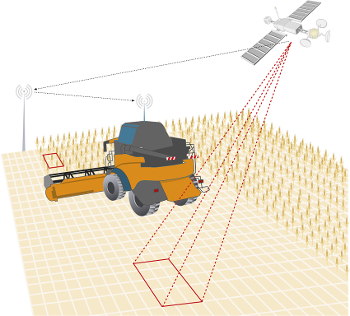Precision agriculture
 Precision farming or precision agriculture is a farming management concept based on observing and responding to intra-field variations. It relies on new technologies like satellite imagery, information technology, and geospatial tools. It is also aided by farmers’ ability to locate their precise position in a field usingsatellite positioning system like GPS.
Precision farming or precision agriculture is a farming management concept based on observing and responding to intra-field variations. It relies on new technologies like satellite imagery, information technology, and geospatial tools. It is also aided by farmers’ ability to locate their precise position in a field usingsatellite positioning system like GPS.
The concept of precision agriculture first emerged in the United States in the early 1980s. In 1985, researchers at the University of Minnesota varied lime inputs in crop fields. It was also at this time that the practice of grid sampling appeared (applying a fixed grid of one sample per hectare). Towards the end of the 1980s, this technique was used to derive the first input recommendation maps for fertilizers and pH corrections. The use of yield sensors developed from new technologies, combined with the advent of GPS receivers, has been gaining ground ever since. Today, such systems cover several million hectares. In the American Midwest (US) it is associated not with sustainable agriculture but with mainstream farmers who are trying to maximize profits by spending money only in areas that require fertilizer. This practice allows the farmer to vary the rate of fertilizer across the field according to the need identified by GPS guided Grid or Zone Sampling. Fertilizer that would have been spread in areas that don't need it can be placed in areas that do, thereby optimizing its use. Around the world, precision agriculture developed at a varying pace. Precursor nations were the United States, Canada and Australia. In Europe, the United Kingdom was the first to go down this path, followed closely by France. In France, precision agriculture first appeared in 1997-1998. The development of GPS and variable-rate spreading techniques helped to anchor precision farming management practices. Today, less than 10% of France’s farmers are equipped with variable-rate systems. Uptake of GPS is more widespread. But this hasn’t stopped them using precision agriculture services, which supplies field-level recommendation maps.
Precision agriculture management practices can significantly reduce the amount of nutrient and other crop inputs used while boosting yields. Farmers thus obtain a return on their investment by saving on phytosanitary and fertilizer costs. The second, larger-scale benefit of targeting inputs—in spatial, temporal and quantitative terms—concerns environmental impacts. Applying the right amount of inputs in the right place and at the right time benefits crops, soils and groundwater, and thus the entire crop cycle. Consequently, precision agriculture has become a cornerstone of sustainable agriculture, since it respects crops, soils and farmers. Sustainable agriculture seeks to assure a continued supply of food within the ecological, economic and social limits required to sustain production in the long term.
Precision agriculture therefore seeks to use high-tech systems in pursuit of this respectable and worthy goal.


